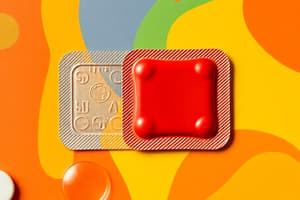Podcast
Questions and Answers
What can result from applying heat to transdermal patches?
What can result from applying heat to transdermal patches?
- Increased duration of drug effect
- Faster drug metabolism in the body
- Reduced drug effectiveness
- Excessive drug absorption and potential toxicity (correct)
Which type of transdermal patch primarily utilizes an adhesive as the drug matrix?
Which type of transdermal patch primarily utilizes an adhesive as the drug matrix?
- Adhesive matrix patches (correct)
- Membrane-matrix hybrid patches
- Reservoir patches
- Non-adhesive patches
What is a defining feature of reservoir patches?
What is a defining feature of reservoir patches?
- They contain a gel-like substance for drug delivery.
- They have a zero-order release pattern. (correct)
- They are the thinnest patch design available.
- They are characterized by a high drug release rate.
What advantage do membrane-matrix hybrid patches provide?
What advantage do membrane-matrix hybrid patches provide?
Which type of device provides drug delivery over extended periods and is used for contraception?
Which type of device provides drug delivery over extended periods and is used for contraception?
How long can intravitreal implants like Retisert provide drug delivery?
How long can intravitreal implants like Retisert provide drug delivery?
What is the primary mechanism of action for Arestin in treating periodontal disease?
What is the primary mechanism of action for Arestin in treating periodontal disease?
What type of drug delivery system is represented by Arikayce for lung disease treatment?
What type of drug delivery system is represented by Arikayce for lung disease treatment?
Which drug is associated with reservoir patches for testosterone delivery?
Which drug is associated with reservoir patches for testosterone delivery?
Which of these advanced delivery systems provide steady release for 8 years?
Which of these advanced delivery systems provide steady release for 8 years?
What is the primary purpose of the occlusive backing in transdermal patches?
What is the primary purpose of the occlusive backing in transdermal patches?
Which of the following characteristics is ideal for drugs intended for transdermal delivery?
Which of the following characteristics is ideal for drugs intended for transdermal delivery?
How do penetration enhancers like ethanol and propylene glycol function in transdermal drug delivery?
How do penetration enhancers like ethanol and propylene glycol function in transdermal drug delivery?
What is a significant consequence of applying transdermal patches to unapproved body areas?
What is a significant consequence of applying transdermal patches to unapproved body areas?
Which statement about patch size and drug release is correct?
Which statement about patch size and drug release is correct?
What limitation of transdermal patches is associated with prolonged occlusive use?
What limitation of transdermal patches is associated with prolonged occlusive use?
What effect does applying heat have on a transdermal patch?
What effect does applying heat have on a transdermal patch?
Which of the following factors can affect drug permeation when using transdermal patches?
Which of the following factors can affect drug permeation when using transdermal patches?
Which of the following is NOT a common penetration enhancer used in transdermal drug delivery?
Which of the following is NOT a common penetration enhancer used in transdermal drug delivery?
What is a potential microbial concern when using transdermal patches?
What is a potential microbial concern when using transdermal patches?
Flashcards
Transdermal drug delivery
Transdermal drug delivery
Delivery of medication through the skin, for systemic effects.
Drug patch components
Drug patch components
Patches have backing, drug layer, adhesive, and release liner.
Ideal drug properties for patches
Ideal drug properties for patches
Small size, lipophilic, and potent at low concentrations.
Penetration enhancers
Penetration enhancers
Signup and view all the flashcards
Mechanism of enhancers
Mechanism of enhancers
Signup and view all the flashcards
Application site considerations
Application site considerations
Signup and view all the flashcards
Patch size and release
Patch size and release
Signup and view all the flashcards
Transdermal patch limitations
Transdermal patch limitations
Signup and view all the flashcards
Occlusion effects
Occlusion effects
Signup and view all the flashcards
Heat and patch usage
Heat and patch usage
Signup and view all the flashcards
Transdermal Patch Types
Transdermal Patch Types
Signup and view all the flashcards
Adhesive Matrix Patch
Adhesive Matrix Patch
Signup and view all the flashcards
Reservoir Patch
Reservoir Patch
Signup and view all the flashcards
Membrane-Matrix Hybrid Patch
Membrane-Matrix Hybrid Patch
Signup and view all the flashcards
Intravitreal Implants
Intravitreal Implants
Signup and view all the flashcards
Intrauterine Devices (IUDs)
Intrauterine Devices (IUDs)
Signup and view all the flashcards
Intravaginal Products
Intravaginal Products
Signup and view all the flashcards
Dental Microsphere Systems
Dental Microsphere Systems
Signup and view all the flashcards
Pulmonary Drug Delivery
Pulmonary Drug Delivery
Signup and view all the flashcards
Excessive Drug Absorption:
Excessive Drug Absorption:
Signup and view all the flashcards
Study Notes
Transdermal Drug Delivery: Patches
- Patches deliver medication through the epidermis, primarily for systemic effects.
- Components: occlusive backing, drug layer with polymer control, adhesive layer, and release liner.
Ideal Drugs for Transdermal Delivery
- Small size: facilitates passage through skin's interlaminar lipids.
- Lipophilic nature: dissolves in skin lipid layers.
- High potency: effective at low concentrations due to limited delivery compared to other routes (oral, injection).
Penetration Enhancers
- Purpose: increase drug permeation.
- Common enhancers: Ethanol and propylene glycol.
- Mechanism: disrupt interlaminar lipids in the stratum corneum, creating pathways for drug movement.
- Other mechanisms: altering keratin to facilitate drug release/prevent binding.
Application Site Considerations
- Adhere to manufacturer-recommended application sites.
- Skin properties vary across body regions (stratum corneum thickness, appendage density).
- Incorrect application sites affect drug absorption and therapeutic response.
Patch Size and Drug Release
- Patch size directly influences drug release over time (flux equation).
- Nitroglycerin patches: different doses achieved by varying patch size while maintaining design.
Limitations of Transdermal Patches
- Limited duration: typically 7-10 days due to occlusion.
- Occlusion effects:
- Increased drug permeation due to enhanced skin hydration and expanded lipid lamellae.
- Skin hydration and maceration: prolonged occlusion can lead to skin breakdown.
- Microbial growth: occluded, moist environment favors pathogen growth.
- Skin changes and altered permeability: occlusion-induced skin changes can alter drug permeability, potentially beneficial in some cases.
Heat and Transdermal Patch Usage
- Heat increases drug release and absorption.
- Potential dangers: excessive drug absorption and toxicity, especially with potent drugs like fentanyl.
Transdermal Patch Designs
Adhesive Matrix Patches
- Common design, adhesive as the drug matrix.
- Advantages: thin, translucent, less noticeable.
- Examples: Nitroglycerin, estradiol, fentanyl, methylphenidate, contraceptive patches, lidocaine, diclofenac.
Reservoir Patches
- Older design; drug reservoir separated from skin by a rate-controlling membrane.
- Characteristics: elevated drug reservoir, potential for leakage, zero-order release pattern.
- Example: testosterone.
Membrane-Matrix Hybrid Patches
- Combine drug matrix with a rate-controlling membrane.
- Advantages: sustained and immediate drug release.
- Drug in the adhesive matrix provides an initial burst effect.
- Examples: clonidine, scopolamine, fentanyl.
Other Advanced Drug Delivery Systems
Intravitreal Implants
- Membrane-controlled reservoir implants sutured into the vitreous humor.
- Example: fluocinolone acetonide for chronic non-infectious uveitis.
- Characteristics: non-biodegradable, 30 months of drug delivery.
Intrauterine Devices (IUDs)
- Membrane-controlled reservoir systems for extended drug release.
- Example: levonorgestrel for contraception (8 years).
Intravaginal Products
- Swellable matrix systems: Example: dinoprostone for cervical ripening.
- Vaginal rings: Flexible membrane-controlled reservoir rings.
- Example: etonogestrel/ethinyl estradiol, estradiol.
Dental Products
- Biodegradable microsphere systems: Example: minocycline for periodontal disease.
- Mechanism: microspheres release drug locally for 21 days.
Pulmonary Drug Delivery
- Liposomal inhalation suspensions: Example: amikacin for Mycobacterium avium complex lung disease.
- Mechanism: liposomes target infection site by macrophage uptake.
Studying That Suits You
Use AI to generate personalized quizzes and flashcards to suit your learning preferences.




